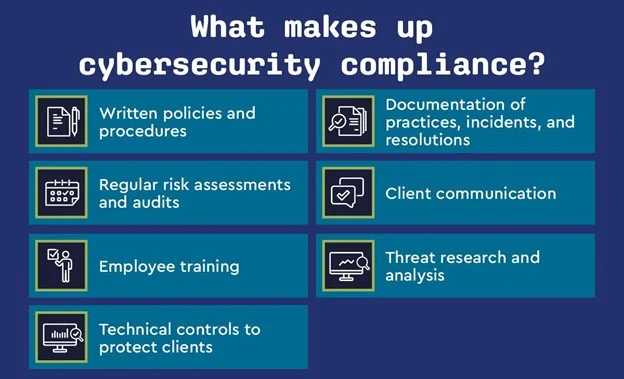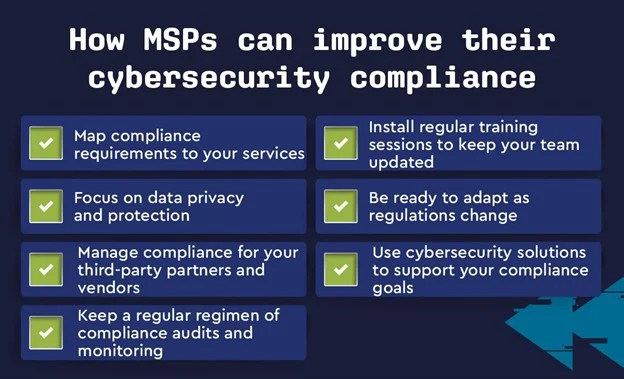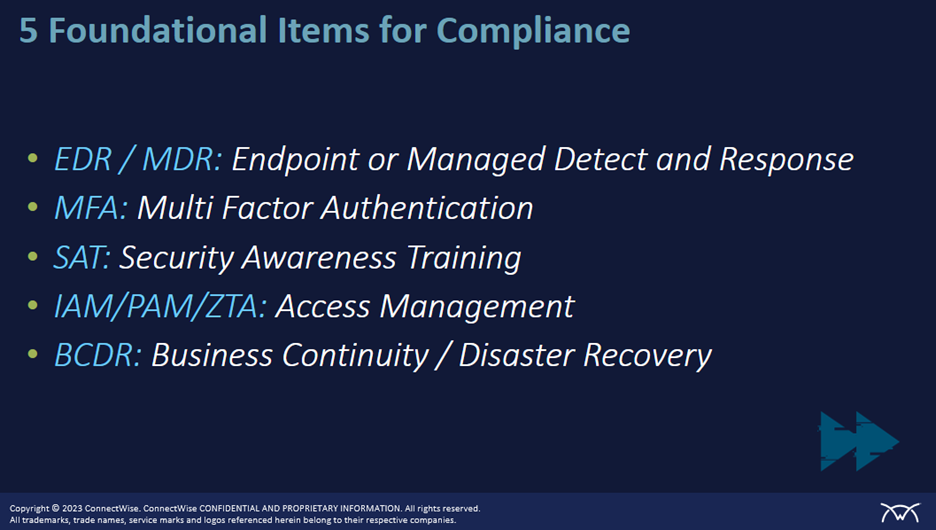Cybersecurity compliance is a critical element in maintaining trust, ensuring data protection, and preventing your clients’ data against cyberthreats. For managed service providers, following proper cybersecurity governance is paramount to operating a successful security practice.
With the constantly evolving state of cybersecurity compliance, it can be challenging for MSPs to develop robust and consistent solutions. In this chapter, we’ll unpack the most important elements of developing a cybersecurity compliance program and the critical regulations you should be familiar with.
Why is cybersecurity compliance important?
The importance of cybersecurity compliance for MSPs cannot be overstated. Whether you work with clients in industries that are highly-regulated or you’re looking to attract more clients in these sectors, cybersecurity regulations can be complex.
Because cybersecurity compliance management can be overwhelming for companies, MSPs have a unique opportunity to include cybersecurity compliance management as part of your cybersecurity offerings.
For most clients, managing cybersecurity compliance entails several key components, including:
- Written policies and procedures to detail security measures, incident response plans, and data handling practices.
- Regular audits and risk assessments to make sure that your organization’s security controls are effective and in line with the latest regulatory demands.
- Frequent employee training that provides all staff members with details on the importance of maintaining cybersecurity compliance.
- Technical controls, such as firewalls, encryption, multi-factor authentication, intrusion detection systems, secure access services edge (SASE) for zero trust secure access, and other technologies that protect client data and systems.
- Proper documentation of all cybersecurity practices, incidents, and resolutions for regulatory purposes.
Cybersecurity regulations play a pivotal role in shaping your organization’s daily operations. From building trust with your clients to following certain industry-specific regulations, cybersecurity compliance should be built into the foundation of your organization.
This commitment is also a commitment to business longevity, truth-building, and reputational management. Clients are far more likely to choose MSPs that demonstrate a strong commitment to cybersecurity and an ethical obligation to compliance and transparency.
However, when an organization adheres to a strict compliance regimen, it can pose certain challenges for MSPs. Because each sector and industry often has unique—and complicated—regulatory requirements, MSPs must stay abreast of trends, rules, and regulations to effectively serve clients.
Additionally, cybersecurity compliance is an inherently complicated topic and often comes with a proliferation of extra paperwork, documentation, and reporting. When supporting your clients with cybersecurity compliance, be aware of the additional energy and time that may be required for success.

The impact of non-compliance
Non-compliance with cybersecurity standards can result in grave consequences for your company and your clients. The implications range from legal penalties and loss of business reputation to much more serious consequences.
Common consequences for non-compliance with security standards include:
- Legal penalties: Cybersecurity regulations often come with stiff penalties for non-compliance, including substantial fines which can cripple small MSPs.
- Data breaches: Non-compliance with regulations often results in vulnerabilities that can be easily exploited by cybercriminals. These breaches expose confidential client information and can result in further legal consequences and penalties.
- Loss of business: Your reputation is crucial for long-term business success. If your organization does not effectively provide compliance and security for clients, losing clients is highly likely.
Because of the growing increase in conversation about cybersecurity and its importance to businesses, news stories about non-compliance tend to gain traction in the news cycle. Some of the most common examples of non-compliance consequences include:
- Instagram and TikTok: In September 2022, Ireland’s Data Protection Commissioner (DPC) fined Instagram $403 million for violating children’s privacy under the terms of the GDPR. Data belonging to minors, particularly phone numbers and email addresses, were made public when users upgraded their profiles to business accounts. One year later, in September 2023, TikTok was handed a $370 million fine by the Irish Data Protection Commission (DPC) for the same violation of data privacy under the GDPR law.
- T-Mobile: In July 2022, T-Mobile announced a settlement for a consolidated class action lawsuit following a data breach that originally occurred in early 2021, impacting 77 million people. T-Mobile agreed to pay $350 million to fund claims submitted by class members and $150 million for data security and related technology in 2022 and 2023.
- Morgan Stanley: In January 2022, Morgan Stanley agreed to pay $60 million to settle a legal claim related to data security. The settlement was in response to a class-action lawsuit filed against the company in July 2020 in regard to two specific security breaches that compromised the personal data of 15 million customers.
Beyond the financial and reputation repercussions of non-compliance with cybersecurity standards, MSPs have a legal and ethical obligation to be compliant. Staying compliant with cybersecurity standards ensures that your MSP is operating within the bounds of the law—which reduces the risk of unexpected legal challenges or financial losses.
Knowing common cybersecurity regulations and standards
In today’s digital world, understanding cybersecurity regulations and standards plays a crucial role in protecting your clients’ data privacy and protection. As your client’s trusted caretaker of their IT infrastructure and data, being well-versed and effective with these regulations is key.
Common cybersecurity regulations and standards include:
- Federal Information Security Management Act (FISMA): FISMA is a US federal law enacted as part of the E-Government Act of 2002. It establishes a comprehensive framework for ensuring the security of information and information systems for all executive branch agencies.
- ISO/IEC 27001: An international standard for information security management systems (ISMS), providing a systematic approach to managing sensitive company information and protecting data security.
- ISO 22301: An international standard that outlines how organizations can ensure business continuity and protect themselves from disaster. This framework can be used by any organization, regardless of size, industry, or location.
In addition to these more common cybersecurity standards, there are different industry-specific requirements for MSPs to become acquainted with:
- Healthcare: Health Insurance Portability and Accountability Act (HIPAA) is one of the most common regulations, providing relevant standards for health information in the United States. If your organization works with healthcare institutions, you must comply with HIPAA to ensure the confidentiality, integrity, and availability of sensitive patient information.
- Financial services: Organizations in the financial sector are governed by strict regulations, such as the Gramm-Leach-Bliley Act (GLBA) which mandates protections for personal financial information.
- Retail: Payment Card Industry Data Security Standard (PCI DSS) is essential for organizations that process, store, or transmit credit card data. This regulation makes sure financial information is stored securely, helping prevent payment card fraud. For MSPs that serve retail clients and handle a high number of card payments, compliance with PCI DSS ensures that payment data remains confidential.
- Energy: The energy sector faces specific regulations, including the North American Electric Reliability Corporation Critical Infrastructure Protection (NERC CIP), which ensures the security of the electrical grid.
Region-specific protections are also important for MSPs to understand:
- North American regulations include the California Consumer Privacy Act (CCPA), which gives Californians the right to know what personal data is collected about them and to refuse its sale. In Canada, the Personal Information Protection and Electronic Documents Act (PIPEDA) is a Canadian federal law that governs the collection, use, and disclosure of personal information by private sector organizations.
- European regulations include the GDPR, which has a wide-reaching impact and requires organizations operating within the EU or dealing with EU citizens’ data to maintain strict data protection standards.
- United Kingdom regulations include the UK-GDPR, which is the UK’s data security regulation that complements the Data Protection act of 2018. It is modeled after the EU-GDPR and governs how UK organizations collect, store, use, and process personal data. It applies to every country in the UK: England, Scotland, Wales, and Northern Ireland.
- Australian-New Zealand regulations include the Essential Eight, which was developed by the Australian Cyber Security Centre (ASCS) to help businesses reduce cybersecurity threats and potential data breaches. The Essential Eight includes eight mitigation strategies for organizations to leverage.
While cybersecurity is a global effort, each region has specific and tailored cybersecurity strategies to protect businesses and develop a safer, more secure digital world. When approaching each cybersecurity challenge, understanding the country-level nuance will provide great clarity and insight.
How to create a cybersecurity compliance program
With a deeper understanding of the importance of cybersecurity compliance for your clients, you’re ready to create a cybersecurity compliance program for your organization. Doing so will help ensure alignment with regulatory requirements, protect sensitive information, and foster trust with your clients and stakeholders.
The most common components of a cybersecurity compliance program include:
- Risk assessment: Identifying potential threats and risks for a client’s information systems, understanding the type of data stored, shared, and accessed. In addition, learn what regulations apply to your organization to serve as a clear foundation for the future.
- Policies and procedures: Developing clear and concise policies that outline your organization’s approach to various cybersecurity issues, including regulatory details for employees.
- Training and awareness programs: Educating employees about different regulatory protocols, encouraging cybersecurity certifications, and providing continuous education.
- Technical controls: Implementing and maintaining proper security measures to protect clients.
- Incident response plan: Developing a structured approach with details on mitigating a cybersecurity incident.
- Regular audits and reviews: Evaluating the efficacy of your security measures, providing alignment with the latest regulatory requirements.
- Vendor management: Making sure that any third-party vendor with access to your systems or data adheres to stringent cybersecurity standards.
As you begin to implement a cybersecurity compliance program, embrace a strategic step-by-step process. Start by identifying the right team member to form a compliance team. While you don’t need an entire department dedicated to compliance activities, it is optimal to leverage the expertise of an information security analyst responsible for tracking compliance requirements.
With the ever-evolving cybersecurity landscape, knowing where to start when building a cybersecurity program can be difficult. Gain the foundational knowledge you need to build resilient cybersecurity offerings in our recent eBook, The Ultimate Operations Guide for MSP Cybersecurity.
How MSPs can improve cybersecurity compliance
Cybersecurity compliance is a cornerstone of trust with your clients—and one that requires a continuous dedication to improving daily processes and bolstering client satisfaction. Consider the following steps to improve your organizational cybersecurity governance.

Map compliance requirements to your MSP services
One of the most effective opportunities to boost cybersecurity compliance is to map requirements to your offered services. By systematically addressing compliance requirements within your service portfolio, you can provide robust cybersecurity while demonstrating your commitment to compliance.
Begin by identifying which regulations are most applicable to your current clients. For example, if you primarily serve healthcare clients, HIPAA is your priority. On the other hand, those in the financial sector might focus on GLBA or PCI DSS.
For each identified regulation, map out how your unique service offerings align. For example, because HIPAA mandates the encryption of data at rest, then your data storage and backup services must inherently include encryption features.
Next, evaluate your service offerings against each regulatory requirement. If gaps are found, consider adjusting your services or incorporating new ones to meet your clients’ needs. Here are some key service offerings that are foundations of any compliance program:

Lastly, maintain clear and organized documentation that details how each service adheres to specific regulatory requirements.
Focus on data privacy and protection
Data privacy and protection have become focal points in the digital age, driven by an increasingly interconnected world and the rise of cyberthreats. One single breach of data can irreparably damage a company’s public image, leading to lost trust and lost revenue.
With regulations like GDPR, CCPA, and HIPAA, data privacy is not just a best practice—it’s a legal obligation. When serving your clients, consider the following best practices and solutions for protecting data:
- Data encryption: Encrypting data both in transit and at rest ensures that, even if malicious actors access the data, they can’t easily decipher it.
- Regular data audits: Periodically assess what data is stored, where it’s stored, how it’s accessed, and why it’s needed. Eliminate any unnecessary data and secure what remains.
- Data access controls: Implement strict access controls to ensure only authorized users can access sensitive data. This includes practices like role-based access control (RBAC) and multi-factor authentication (MFA).
- Secure data disposal: When data is no longer needed, it should be securely disposed of—whether that means securely deleting digital files or shredding physical documents.
- VPN and secure connections: Any remote access to data must be done through secure channels, such as virtual private networks (VPNs).
In addition, following data breach notification requirements is key. Stay informed about any specific data breach notification requirements in the jurisdictions where your clients operate. Requirements vary widely—from the definition of a breach to the timeline and method of the notification.
Manage third-party compliance
Third-party vendors and service providers often play a supportive role in the operational efficiency of your business. However, these providers can also introduce potential vulnerabilities in your organization’s infrastructure—posing risks to your company as well as your clients.
Managing third-party compliance should be an indispensable component of your overarching cybersecurity strategy. Any vulnerability introduced by a third-party can lead to breaches that impact multiple clients, multiplying potential damage.
Plus, if you’re leveraging third-party tools and solutions into your service stack, the complexity of the IT environment increases. This has the potential to introduce new vulnerabilities or compliance patch management.
When hiring third-party vendors, make sure to incorporate the following steps:
- Set clear compliance expectations in your contractual agreements. This should include the right to audit a third party’s compliance posture and provide details on how vendors handle, store, and process data in alignment with regulatory and industry standards.
- Set aside time for regular monitoring and audits with your third-party vendors. Implement continuous monitoring tools and practices to keep a real-time eye on data and integrations.
Many compliance regulations hold companies accountable for breaches—even if the source was a third-party vendor. Failure to ensure third-party compliance can result in hefty fines and reputational damage.
Monitoring, compliance reporting, and audits
While third-party compliance management is essential, your internal compliance framework is equally crucial. Monitoring, reporting, and regular audits are necessary for your organization.
- Use real-time monitoring solutions. This allows for the swift detection of security events or incidents. Consider security information and event management (SIEM), endpoint detection and response (EDR), and network traffic analysis as real-time monitoring solutions.
- Maintain regulatory standards. Continuous audits and monitoring ensure that an MSP adheres to the evolving compliance landscape and mitigates risks of regulatory penalties. Offer clients customizable compliance reports tailored to their industry regulations and requirements and hold periodic briefings.
- Hold internal audits. Regular reporting provides insights into efficiency, helping to identify areas that require improvement. Schedule internal audits that scrutinize every aspect of your operations. Address any non-compliance findings and treat these with urgency.
Train and educate your cybersecurity teams on compliance
Because cybersecurity is an inherently complex topic, regular training and education with your team is the cornerstone of a resilient defense. While tools and technologies are helpful, the team members who operate these tools are just as critical.
Provide regular training sessions focusing on the importance of cybersecurity compliance, the reasons behind certain regulations, and the implications of non-compliance. By contextualizing the day-to-day operations of upholding cybersecurity compliance, team members will feel empowered and confident in their ability to play a role in securing clients’ confidential data.
Be ready to follow and adapt to regulation and requirement changes
Cybersecurity is a consistently evolving field—and as it continues to shift, new threats, technologies, and best practices will become available. To best protect businesses, regulations will also evolve in tandem.
As an organization, staying ahead of these evolving regulations ensures business longevity and upholds trust with your clients. To achieve this, consider the following actions:
- Pick a dedicated compliance team or team member responsible for tracking regulatory changes and providing timely updates to company practices.
- Subscribe to regulatory updates from industry associations or government bodies that issue cybersecurity regulations.
- Regularly review internal policies and protocols to ensure alignment with current regulations.
- Consult with legal experts who specialize in cybersecurity to gain a full understanding of any intricacies.
For more resources to help MSPs stay on top of these changes, this blog is a great starting point to learn about the main regulations to focus on for your business. To take this step even further, our Cyber Research Unit helps identify new vulnerabilities and threats to help make sure you’re always at the forefront of areas like data privacy and protection.
In addition, as AI becomes commonplace with many organizations and industries, new cybersecurity regulations will likely follow suit. From AI-powered threats and data privacy concerns, to bias and decision-making, expect AI security to warrant new regulations and policies to protect users and businesses.
Cybersecurity solutions to ease the compliance process
Compliance in cybersecurity is far more than just a quick checklist to follow. Instead, it’s an integral and transformative component that shapes the ethos of your company. Mastering the cybersecurity compliance process not only safeguards your company’s reputation but it fortifies client trust.
Many modern cybersecurity solutions empower MSPs while developing a cybersecurity compliance practice:
Cybersecurity tools also empower teams with a scalable solution—so as your client base grows or as services expand, compliance standards remain consistent. For MSPs, this means less time spent grappling with compliance challenges and more time spent delivering outstanding service for clients.
At ConnectWise, we understand that navigating the nuance of cybersecurity solutions can be overwhelming and complicated. That’s why our comprehensive cybersecurity suite offers MSPs a number of critical tools to streamline daily tasks, streamline compliance reporting, and offer real-time monitoring and alerts.
Watch a demo of our cybersecurity suite today or learn about our Cybersecurity Research Unit (CRU) for up-to-date threat intelligence and cybersecurity resources for MSPs.











